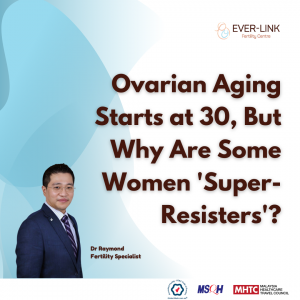
We’ve all heard that fertility declines with age, especially after 35. But did you know that ovarian aging actually begins much earlier as early as your late 20s or early 30s? Yet, despite this decline, there are women in their 40s who conceive naturally and even have healthy IVF outcomes without donor eggs. These women are often referred to in recent research as “ovarian aging super resisters”, a fascinating group whose ovaries defy the normal timeline. So, what makes these women different? And can science learn from them to help others protect their fertility?
Ovarian Aging: When Does It Actually Start?
Women are born with all the eggs they will ever have around 1 to 2 million at birth. By puberty, that number drops to about 300,000, and with every menstrual cycle, a few hundred more eggs are lost. By the age of 30, ovarian reserve (the number of eggs) begins to decline gradually. After 35, the drop becomes steeper both egg quantity and quality decline. By age 40, fertility drops significantly, and miscarriage rates rise. But not all women follow this pattern.
Who Are the “Super Resisters” to Ovarian Aging?
Recent research has discovered that a small group of women seem to defy the typical timeline. These women, often over 40, still have:
- High Anti Müllerian Hormone (AMH) levels
- Regular menstrual cycles
- Good egg quality
- Natural conception or good IVF outcomes without needing egg donors
In 2022, a groundbreaking study led by Dr. Kutluk Oktay (Nature Aging) identified women over 40 with younger than expected ovaries based on blood tests and ultrasound scans. These women were labeled as “oocyte longevity outliers”, or “ovarian super resisters.”
What’s Their Secret? Genetics, Lifestyle, or Something Else?
Researchers believe that these women may carry protective genetic variants that slow down the depletion of eggs or preserve egg quality for longer. The Nature Aging study identified unique DNA sequences involved in DNA repair pathways, especially the BRCA1-related family of genes, that may slow the natural aging of ovarian cells.
Other possible factors:
- Low oxidative stress: Their bodies may naturally manage free radicals better, reducing egg cell damage.
- Efficient mitochondrial function: Their egg cells may have more energy to survive longer.
- Stable hormonal signaling: Their follicles may respond better to hormonal cues, leading to regular ovulation even in later years.
This opens the door for future fertility therapies that might target these protective pathways.
Can You Test If You’re a Super Resister?
Currently, there’s no standard test to identify super resisters. But signs may include:
- High AMH levels (>2.0 ng/mL) after age 40
- Antral follicle count (AFC) above 10
- No signs of perimenopause (hot flashes, cycle changes)
Still, it’s important to note that these women are rare and most people experience ovarian aging according to the typical timeline.
Can You Slow Down Ovarian Aging?
While you can’t stop the clock, you may slow it down by:
- Avoiding smoking and toxins
- Managing stress
- Maintaining a healthy weight
- Eating antioxidant rich foods
- Freezing eggs early, especially if you have risk factors (like family history of early menopause)
Conclusion
Ovarian aging is real and it starts earlier than most people think. But the exciting discovery of “super resisters” proves that some women’s ovaries age much slower than expected. Scientists are now studying these women to unlock the secrets of long lasting fertility. While not everyone is lucky enough to be a super resister, understanding ovarian aging helps you take proactive steps. Whether it’s egg freezing, early testing, or lifestyle changes, knowledge is power and timing is everything when it comes to protecting your fertility.

